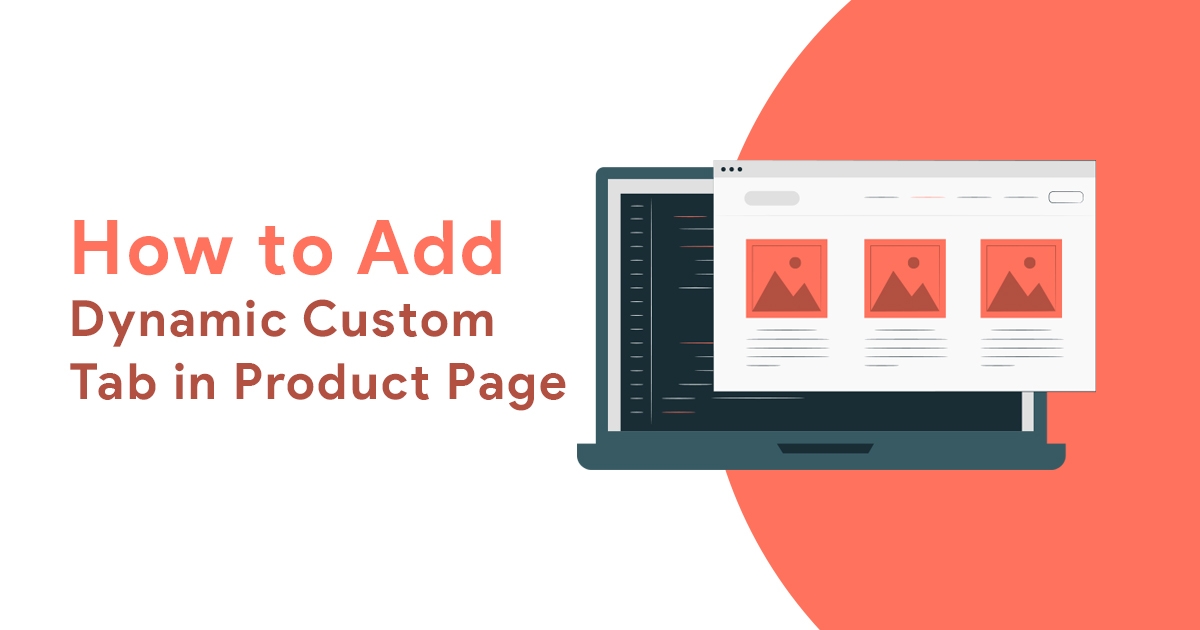How to Add Dynamic Custom Tab in Product Page Magento 2

Magento 2 provides much information about the product on the Product details page. Tabs are more useful when a product has multiple types of descriptions and information. We can add a custom tab on the product details page. If you need to add dynamic custom tabs on the product details page then follow the below steps to achieve this.
Step-1: Create registration.php
Create registration.php at app/code/Dolphin/DynamicCustomTabs
<?php
\Magento\Framework\Component\ComponentRegistrar::register(
\Magento\Framework\Component\ComponentRegistrar::MODULE,
'Dolphin_DynamicCustomTabs',
__DIR__
);
Step-2: Create module.xml
Create module.xml at app/code/Dolphin/DynamicCustomTabs/etc
<?xml version="1.0"?>
<config xmlns:xsi="http://www.w3.org/2001/XMLSchema-instance" xsi:noNamespaceSchemaLocation="urn:magento:framework:Module/etc/module.xsd">
<module name="Dolphin_DynamicCustomTabs" setup_version="1.0.0">
<sequence>
<module name="Magento_Catalog"/>
<module name="Magento_Backend"/>
</sequence>
</module>
</config>
Step-3: Create events.xml
Create events.xml at app/code/Dolphin/DynamicCustomTabs/etc
<?xml version="1.0"?>
<config xmlns:xsi="http://www.w3.org/2001/XMLSchema-instance" xsi:noNamespaceSchemaLocation="urn:magento:framework:Event/etc/events.xsd">
<event name="layout_generate_blocks_after">
<observer name="dyanmic_tabs_add" instance="Dolphin\DynamicCustomTabs\Observer\DynamicTabs" />
</event>
</config>
Here event is only generated during the initial page render on a non-cache page. At that time we add dynamic child blocks for the custom tab.
Step-4: Create DynamicTabs.php
Create DynamicTabs.php at app/code/Dolphin/DynamicCustomTabs/Observer
<?php
namespace Dolphin\DynamicCustomTabs\Observer;
use Dolphin\DynamicCustomTabs\Model\TabConfig;
use Magento\Framework\Event\Observer;
use Magento\Framework\Event\ObserverInterface;
class DynamicTabs implements ObserverInterface
{
const PARENT_BlOCK_NAME = 'product.info.details';
const RENDERING_TEMPLATE = 'Dolphin_DynamicCustomTabs::dynamic_tab_renderer.phtml';
private $tabs;
public function __construct(TabConfig $tabs)
{
$this->tabs = $tabs;
}
public function execute(Observer $observer)
{
$layout = $observer->getLayout();
$blocks = $layout->getAllBlocks();
foreach ($blocks as $key => $block) {
if ($block->getNameInLayout() == self::PARENT_BlOCK_NAME) {
foreach ($this->tabs->getTabs() as $key => $tab) {
$block->addChild(
$key,
\Magento\Catalog\Block\Product\View::class,
[
'template' => self::RENDERING_TEMPLATE,
'title' => $tab['title'],
'jsLayout' => [
$tab
]
]
);
}
}
}
}
}
Here we add custom tabs array to page layout child block in product.info.details container block.
Step-5: Create dynamic_tab_renderer.phtml
Create dynamic_tab_renderer.phtml at app/code/Dolphin/DynamicCustomTabs/view/frontend/templates
<?php
if (!empty($block->getJsLayout())) {
$jsLayout = \Zend_Json::decode($block->getJsLayout());
foreach ($jsLayout as $layout) {
if (isset($layout['type']) && 'template' === $layout['type'] && isset($layout['data'])){
echo $this->getLayout()->createBlock($layout['data']['type'])
->setDisplayType($layout['data']['name'])
->setTemplate($layout['data']['template'])->toHtml();
} else {
?>
<h1><?= $layout['title']; ?></h1>
<div><?= $layout['description']; ?></div>
<?php
}
}
}
Step-6: Create di.xml
Create di.xml at app/code/Dolphin/DynamicCustomTabs/etc/frontend
<?xml version="1.0"?>
<config xmlns:xsi="http://www.w3.org/2001/XMLSchema-instance" xsi:noNamespaceSchemaLocation="urn:magento:framework:ObjectManager/etc/config.xsd">
<type name="Magento\Catalog\Block\Product\View\Details">
<plugin name="add_tab_product_view_page_description" type="Dolphin\DynamicCustomTabs\Plugin\Description" />
</type>
</config>
Step-7: Create Description.php
Create Description.php at app/code/Dolphin/DynamicCustomTabs/Plugin
<?php
namespace Dolphin\DynamicCustomTabs\Plugin;
use Dolphin\DynamicCustomTabs\Model\TabConfig;
class Description
{
private $tabs;
public function __construct(
TabConfig $tabs
) {
$this->tabs = $tabs;
}
public function afterGetGroupSortedChildNames(
\Magento\Catalog\Block\Product\View\Details $subject,
$result
) {
if (!empty($this->tabs->getTabs())) {
foreach ($this->tabs->getTabs() as $key => $tab) {
$sortOrder = isset($tab['sortOrder']) ? $tab['sortOrder'] : 45;
$result = array_merge($result, [ $sortOrder => 'product.info.details.' . $key]);
}
}
return $result;
}
}
Step-8: Create TabConfig.php
Create TabConfig.php at app/code/Dolphin/DynamicCustomTabs/Model
<?php
namespace Dolphin\DynamicCustomTabs\Model;
class TabConfig
{
private $tabs = [
'tabA' => [
'title' => 'Dyanmic Tab A',
'description' => 'Dynamic Tab A Description',
'sortOrder' => 50
],
'tabB' => [
'title' => 'Dynamic Tab B',
'description' => 'Dynamic Tab B Description',
'sortOrder' => 60
],
'tabC' => [
'title' => 'Dynamic Tab C',
'description' => 'Dynamic Tab C Description',
'sortOrder' => 70
],
];
public function getTabs()
{
return $this->tabs;
}
}
Here we define an array of dynamic tabs. we can add phtml file in custom tabs using the below array structure:
'tabD' => [
'title' => 'Dynamic phtml Tab',
'type' => 'template',
'data' => [
"type" => "Magento\Framework\View\Element\Template",
"name" => "dynamic.phtml.custom.tab",
"template" => "Dolphin_DynamicCustomTabs::TemplateFileName.phtml"
],
'description' => '',
'sortOrder' => 80
]
We can also add a widget to dynamically in custom tabs using below array structure:
'tabE' => [
'title' => 'Recently Viewed',
'type' => 'template',
'data' => [
"type" => "Magento\Reports\Block\Product\Widget\Viewed",
"name" => "custom.recently.view.products",
"template" => "Magento_Reports::widget/viewed/content/viewed_list.phtml"
],
'description' => '',
'sortOrder' => 90
],
you can also create a UI form to store the above data and maintain dynamic tabs using database entry. you need to follow the above array structure to store and retrieve data for dynamic custom tabs.
I hope this helps you. For any doubts regarding this topic, please write your doubts in the comments section.

Hello!
Click one of our contacts below to chat on WhatsApp
